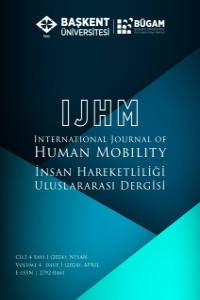Aim & Scope
The International Journal of Human Mobility (IJHM) is an open-access peer-review journal that aims to contribute to the diversification and enrichment of migration studies in a way that meets today’s changing conditions and needs, supporting relational studies that go beyond classical approaches and examine differences and uncertainties with a process-based approach.
IJHM welcomes research addressing the migration phenomenon both from the academic community and from the members of public, private and civil organizations and aiming at a holistic approach to migration, which contains complex and multidisciplinary processes. IJHM includes original empirical research, compiled works, case studies, short articles, and book reviews. IJHM has a flexible and multi-purpose structure, such as issue editions and special issues, where different approaches and disciplines can contribute. It aims to include studies with critical points of view and create a scholarly platform that opened to all researchers can freely share their work.
Author Guidelines
General Format Features
• Font All Text should use a 12-point Times New Roman font.
• Page Setup should be on A4 paper with top, bottom, right and left spaces 2.5 cm, based on both sides, without hyphenation at the end of the line.
• Studies should be prepared as a single column. Paragraphs and headers should not have indents and protrusions.
• Paragraph structure in the indents section on the Paragraph tab;
• Before and after area 0.6 cm
• The row pitch should be 1.5 cm
Word counts by Article types
Research paper (12000 words, including bibliography)
Compilation article (3500-7000 words)
Book Review (1000-1500 words, including bibliography)
Film, documentary, Show, Exhibition, etc. Criticism (1000-2000 words)
Academic Meeting (Symposium, Conference, Workshop, etc.) Criticism (1000-2000 words)
Interview with well-known scholars, artists working in the field (1000-2000 words)
Letter/comment to the editor (500-1000 words)
Case report (1000-1500 words)
Working Sections
Title: Article title should be bold and left-aligned. If the work was previously presented, produced from a project or thesis, etc., this information should be provided by a footnote at the end of the title.
Author names: Author names must be straight. Full names, titles, institutions in which they work, address, telephone and e-mail information of the author/authors should be indicated.
Abstract: It should be between 150-200 words without any citation or reference.
Keywords: Must be between 5-8 words.
Extended summary: No more than 650 words should be presented for the extended summary.
Main text: Should include sections of introduction, methods, findings and discussion, conclusions and recommendations.
The method section: Should include sampling/ participants information, data collection tools, and analysis. The model subsection should only be included if an original model is used.
The main text structure may vary depending on the type of subject. However, the created subsections should not make the text fragmented and challenging to follow up by readers.
Bibliography: Publication Manual of the American Psychological Association (APA), published by the American Psychological Association, both in text and Bibliography (6. the spelling rules specified in the book (print) should be applied.
Tables, Figures and Attachments
Table and shapes: Table, shape, picture, chart, etc. elements must be included in the text but not given separately at the end of the study.
Table and shape expressions (such as Table 1, Figure 1) should be written in plain font[EGA7] . Table and figure headers should be written in italics.
In tables and figures, the 9-point Times New Roman font is used outside the general template. In the indents section on the Paragraph tab;
• Before and after field 0 nk,
• Line spacing should be single.
Tables and figures must be aligned left, and text scrolling must be turned off. See the sample article for a table representation.
Attachments: Each attachment should be given on separate pages after the bibliography.
Ethical Principles and Publication Policy
As the International Journal of Human Mobility, one of our significant goals is to ensure the quality standard and continuity of the peer-reviewed publications. In this context, the IJHM adopts the principles of the Committee of Publication Ethics (COPE), a formation dedicated to training, informing and supporting editors, publishers and people related to publication ethics who have been working in the field of ethical practices in publishing culture for more than twenty years. For more information: https://publicationethics.org IJHM is responsible for providing equal opportunities to the authors regardless of race, religion, gender, political views, academic title and institutional affiliations.
According to the accepted publication ethics, the privacy of all articles submitted to the Journal is guaranteed, except for the works submitted to more than one publication outlet at the same time or containing plagiarism. If not publish decision is taken at any stage during the evaluation, information about the article will not be shared with third parties in any way.
Price Policy
The International Journal of Human Mobility provides free and unlimited access to all studies. The Journal is open-access, and no fees will be charged for publication.

